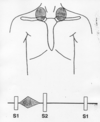Cardiology Flashcards
(18 cards)
What are the 8 common lesions of congenital heart disease?
- ventricular septal defect (VSD)
- patent duct arteriosis (PDA)
- atrial septal defect (ASD)
- pulmonary stenosis
- aortic stenosis
- coarctation of the aorta
- transposition of the great arteries
- tetralogy of fallot
What is the aetiology of congenital heart disease?
- genetic susceptibilty
- teratogenic insult
- drug
- infections
- Toxoplasma, Rubella, CMV, Herpes
- maternal
- diabetes, SLE
- chromosomal abnormalities
- trisomy 13, 18, 21, Turner, Noonan, Williams, 22q11 deletion
What are some features of congenital heart disease?
- feeding, weight, development
- cyanosis
- tachypnoea, dyspnoea
- exercise tolerance
- chest pain
- syncope
- palpations
- joint problems
- dysmorphic features
- clubbing
- pulses, apex
- heart sounds
- murmers
What are investigations for congenital heart disease?
- blood pressure
- O2 saturation, arterial BGA
- ECG
- CXR
- echocardiogram
- catheter
- angiography
- MRI/A
- exercise testing
What is Still’s murmur (LV outflow murmur)?
- 2-7 yrs
- soft systolic
- mcial, vibratory, twang
- apex, left sternal border
- inc. in supine position + exercise

What is pulmonary outflow murmur?
- 8-10 yrs
- soft systolic, vibratory
- upper left sternal border, well localised, not radiating to back
- inc. in supine position + exercise
- often children with narrow chest

What is carotid/brachiocephalic arterial bruits?
- 2-10 yrs
- 1-2/6 systolic, harsh
- supraclavicular, radiates to neck
- inc. in exercise, dec. on turning head or extending neck

What is venous hum?
- 3-8 yrs
- soft, indistinct
- continuous murmur, sometimes with diastolic accentuation
- supraclavicular
- only in upright position, disappears on lying down or turning head

What are ventricular septal defects?
- 3 main types
- subaortic
- perimembranous
- muscular
- L to R shunt

What are the clinical presentation of ventricular septal defects?
- pansystolic murmur
- lower left sternal edge
- sometimes with thrill
- in very small VSDs- early systolic murmur
- in very large VSDs- diastolic rumble due to relative mitral stenosis
- also signs of cardiac failure -> biventricular hypertrophy, pulmonary hypertension

How are ventricular septal defects closed?
- amplatzer, occlusive device, trans-catheter
- patch closure, open heart surgery
What are atrial septal defects?
- can close spontaneously
- can be detected in adulthood
- as; AF, heart failure, pulmonary hypertension
- wide fixed splitting of 2nd heart sound, pulmonary flow murmur
What is pulmonary stenosis?
- mild- asymptomatic
- moderate/severe- exertional dyspnoea, fatigue
- ejection systolic murmur
- upper left sternal border
- radiation to back

What is aortic stenosis?
- mostly asymptomatic
- severe- dec. exercise tolerance, exertional chest pain, syncope
- ejection systolic murmur
- upper right sternal border
- radiation into carotids
What are normal changes in fetal circulation at birth?
- pulmonary vascular resistance falls
- pulmonary blood flow rises
- systemic vascular resistance is inc
- ductus arteriosis closes
- foramen ovale closes
- ductus venosus closes
What is patent duct arteriosis (botalli)?
- very common in pre-term infants
- treat with fluid restriction/diuretics, prostaglandin inhibitors, surgical ligation
- term babies- good chance of spontaneous closure
What are investigations for co-artication of the aorta?
- 3D MRI scan
What is the management for co-artication of the aorta?
- re-open DA with prostaglandins E1 or E2
- resection with end-to-end anastomosis
- subclavian patch repair
- balloon aortoplasty


